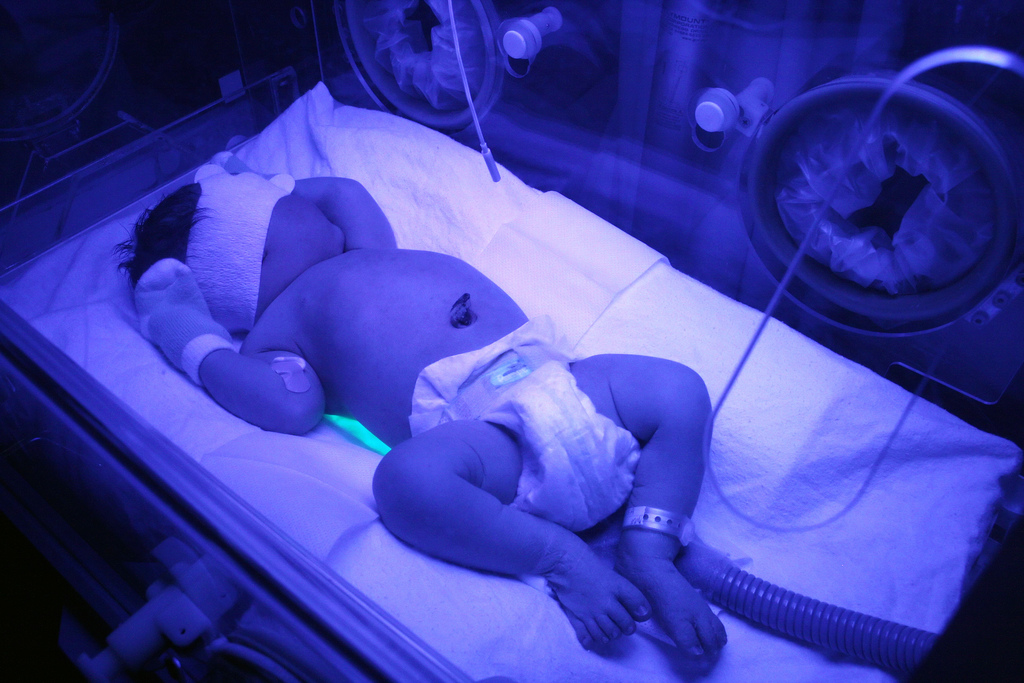Neonatal jaundice is a condition that affects many babies while they are still in the maternity ward. This illness has been known and treated since our great-grandmothers’ times. Today, more effective treatments are available and the chances of a baby with neonatal jaundice being discharged together with the mother are much higher than they were 10 years ago. But after all, what is jaundice and how is it treated?
What is Neonatal Jaundice?
Jaundice or hyperbilirubinemia1 is nothing more than the yellow coloring of the skin, eyes, and urine, which are caused by an excess of bilirubin in the baby’s body. The liver, which is responsible for processing bilirubin in the baby’s body, cannot keep up with the demand and, as a result, bilirubin ends up accumulating and needs some help to be eliminated from the body.
Yellowing or neonatal jaundice may not be a serious disease and sometimes are not even considered diseases at all; it is a natural condition that most newborns go through. The incidence of neonatal jaundice among newborns is quite high; about 1 in every 3 births result in babies with excess bilirubin in their bodies. In premature babies, this number can be even higher, about 1 in every 2 births.
When Does Neonatal Jaundice Occur
Typically, neonatal jaundice appears between 3 and 10 days after birth, starting first in the membrane of the eyes, then progressing to the face, chest, abdomen, and finally to arms and legs. In addition to the yellow coloring, a simple blood test can detect and determine the level of jaundice. However, depending on the severity of the jaundice, no medical treatment may be needed; only cases where levels are much higher than normal require treatment.
Explanatory Video
Treatment for Jaundice – The Sun is the Source of Life
The treatment for neonatal jaundice is very simple: just a session of phototherapy2 using purple or white lights in the hospital if the case is more severe, or sunbaths at home for milder and more common cases, to drastically reduce the bilirubin in the baby’s body. But how does light help in these cases? Ultraviolet light or sunlight acts on the baby’s skin, transforming the excess bilirubin into substances more easily processed by the liver.
Treatment for neonatal jaundice in the maternity ward can vary depending on the case. If the baby requires phototherapy, they may stay an extra day or two in the hospital to help the body eliminate the yellowing. But if the case is milder, sunbaths in the morning and/or afternoon may be sufficient.
How to Notice Improvement
You can notice improvement very quickly, since skin that was previously very yellow starts to take on a more normal tone after the second sunbath or the first day of phototherapy. However, there are cases where neonatal jaundice can become dangerous, so the pediatrician must investigate if it’s a case of obstructive jaundice, which is more common in adults.
Risks if Jaundice is Not Treated
The accumulation of bilirubin3 in the body can be dangerous and cause neurological damage, but this only occurs in extreme cases. It is essential that at any sign of yellowing, the baby is taken to the maternity or trusted pediatrician for an evaluation—and, of course, to have sunbaths.
Reader’s Story:
Gisele is the mother of 3 children and all of them had neonatal jaundice and needed phototherapy to help their bodies process the bile. She shares a bit of her story:

Manu stayed in the nursery for 2 days of light treatment, and since we had already reached the limit of my stay at the hospital, I had to go home before her. Only on the third day could she come home, and I continued the treatment with sunbaths and vitamin D.
It was the same with Rafa. He was only discharged after 3 days, but this time we were calmer because we knew it was not serious. With Rodrigo it was different; he had his light treatment in the maternity room, didn’t leave my side even for a minute, and it was much calmer since we were discharged together, even though he had to continue the treatment for one more day.”
Warning Signs
Moms, just pay attention to signs that appear after arriving home, since neonatal jaundice can appear from the 3rd to the 10th day of the baby’s life. Even if the baby does not show signs of yellowing, it is very important that they get morning sunbaths to prevent jaundice from appearing.
Some old-fashioned remedies can also help besides sunbaths, such as a bath with picão water (a common leaf sold in natural product stores), which the elderly say helps eliminate excess yellowing and significantly decrease neonatal jaundice. Or even the myth that a spoon of weak coffee could help the liver filter out the yellow … myth or truth?
What really counts is giving the baby sunbaths, whether or not there are signs of neonatal jaundice, and always giving vitamin D before some gentle morning sun.
See also: Reflux in Newborns – How to Diagnose and Treat
Photo: Justus Hayes












